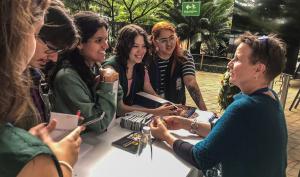Meeting ITER in Medellín, Colombia
What a setting for a conference! A sprawling expanse of green, the large botanical garden of Colombia's second biggest city Medellín provided the venue for the 12th World Conference of Science Journalists. About four hundred journalists, media experts and communicators from all corners of the globe met in person in the "city of eternal spring" to exchange experiences, share ideas and learn from one another.
In a somewhat sobering contrast to the pleasant surroundings, the conference addressed a number of serious themes affecting public discourse across the world. As it was the first conference since the COVID pandemic, this subject was one of the hottest topics—in particular its impact on science journalism and the need to confront disinformation and misinformation.
Journalists examined a range of other crucial issues, such as the role of public policy in science and technology, food security and food safety, and the practical and ethical implications of new biotechnologies. Focus sessions dealt with the essence of the journalistic trade—reporting on risk and uncertainty in science, the question of whether humour has its place in science journalism, or the use of new media technologies.
Climate change was the underlying theme for many discussions. Here in particular, it was interesting to note the move toward solutions-oriented journalism, focusing on exploring answers to challenges rather than just dwelling on problems. The plenary on energy security—with ITER's participation—was a good example. Panellists discussed access to energy, with an emphasis on the development of energy solutions that are environmentally sustainable in a world that has to deal with the increasing effects of climate change.
The presentation of the ITER project—both at the conference's "story corner" as well as in the plenary—raised the question of how developing countries will be able to benefit from fusion technology in the future. In anticipation of concrete political measures to enable the worldwide sharing of fusion technology, it was agreed that steps could and should be taken now to stimulate the development of fusion-related scientific and technological capacities through targeted investment in education and research in developing countries.
The World Conference of Science Journalists provided yet another stage to show that fusion is a long-term solution for addressing the world's energy problems and helping to combat the effects of climate change. Many invitations were extended to conference participants, and the ITER Project hopes that science journalists from all over the world will visit for a first-hand experience!



